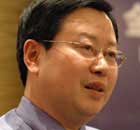Economy and Business
Circular economy helps bring big cash to Ankang
By Lu Hongyan (China Daily Shaanxi Bureau)
Updated: 2010-06-01 16:30
 |
Large Medium Small |
Ankang, located in the Qinling Mountains of Shaanxi province, has blazed a new trail in protecting the local environment and making the city prosper by developing five green industries covering clean energy, new materials, enriched foods, bio-medicine and silk.
Assistant Mayor Li Chunlin said the city netted a gross domestic product (GDP) of 27.5 billion yuan ($4.1 billion) in 2009, an increase of 15 percent over the previous year, and reaped a fiscal revenue of 3 billion yuan, a hike of 15.4 percent.
Ankang, which is situated in southern Shaanxi, administers one district, seven counties and two county-level cities.
Pigs now a great cash-earner
Ankang Yangchen Animal Husbandry Science & Technology Co. Ltd. the largest aquaculture plant in northwestern China, is a breeding company focused on pig production. For byproducts alone, the plant processes more than 25,000 tons of pig manure each year.
By adopting the technologies of "rain sewage diversion" and "dry and clean manure" in a bid to cut pollutants and building large-scale bio-gas power generation projects, the company can now treat more than 90,000 tons of pig manure each year, which helps to bring out 142,400 cubic meters of bio-gas, 66,000 tons of bio-gas slurry fertilizer, more than 10,000 tons of residue organic fertilizer and produce 3.5 million kW of electricity a year.
This helps the business to usher in the model of a virtuous circle in achieving aquaculture development, renewable energy, fertilizer production and protecting the environment, according to Li.
At Hengyuan Biochemical Co in Xunyang County, independent R&D in turmeric hydrolysis treatment technology has helped the business raise the comprehensive utilization of turmeric from the previous 2 percent to 90 percent while cutting the rate of material consumption by 10 percent. In the process, the workers also saved water by more than 80 percent and reduced wastewater emissions by 90 percent.
During the past few years, the city has dedicated itself to promoting the development of a "green economy," Li said.
In 2009, the city's output value of green industries in enriched food, silk, Qinba medicine and eco-tourism jumped by more than 55 percent.
Li noted that this year, the city's new "green industries" in konjac processing and tea paperboard production are likely to add another output value of 2 billion yuan.
"Circular economy is first of all low consumption, low emission and high efficiency," said Zhong Shunhu, a member of the Standing Committee of Ankang City Committee of the Communist Party of China and also the city's publicity chief, adding that the city expands its ecological agriculture base on the one hand while developing new unique industries, so as to extend the industrial chain and help enrich the farmers.
By using lead and zinc tailings to make brick and new-type wall materials, Ankang is able to make the tailings utilization rate reach 80 percent, according to Zhong.
At Xiushanlong Special Cement Plant, the business can consume 100,000 tons of tailings by making use of tailings as clinker additives to cement.
Wang Shaofeng, chief engineer at the Ankang City Development and Reform Commission, said by relying on resource advantages, the city focuses on developing eight industrial chains covering hydrothermal power, new materials, new building materials, bio-energy, bio-medicine, green food processing, equipment manufacturing and recycling.
He noted that by improving the industrial chain and nurturing industrial clusters to promote the aggregation rate, in a bid to change the previous linear model of “resources - products – waste” to a circular mode of “resources - products - waste - renewable resources,” the city has achieved a win-win in both environmental protection and economic development.







